MOC Doped with Graphene Nanoplatelets: The Influence of the Mixture Preparation Technology on Its Properties
Abstract
1. Introduction
2. Materials and Methods
2.1. Chemicals
2.2. Synthetic Procedures
2.3. Analytical Techniques
3. Results and Discussion
4. Conclusions
- The addition of graphene did not increase the viscosity of the fresh mixtures, which is positive for their presumed application in the design and development of the advanced types of multi-component MOC composites for construction applications.
- Both presented mixing procedures designed for MOC mixtures with graphene enabled the production of materials with decreased porosity and greatly improved mechanical resistance, in comparison with the ordinary MOC paste.
- The two-step mixing technique even improved the structural and mechanical parameters acquired for MOC-graphene composite homogenized using the one-step technology.
Supplementary Materials
Author Contributions
Funding
Institutional Review Board Statement
Informed Consent Statement
Data Availability Statement
Acknowledgments
Conflicts of Interest
References
- Cataldi, P.; Athanassiou, A.; Bayer, I.S. Graphene nanoplatelets-based advanced materials and recent progress in sustainable applications. Appl. Sci. 2018, 8, 1438. [Google Scholar] [CrossRef]
- Du, H.; Pang, S.D. Enhancement of barrier properties of cement mortar with graphene nanoplatelet. Cem. Concr. Res. 2015, 76, 10–19. [Google Scholar] [CrossRef]
- Tong, T.; Fan, Z.; Liu, Q.; Wang, S.; Tan, S.; Yu, Q. Investigation of the effects of graphene and graphene oxide nanoplatelets on the micro- and macro-properties of cementitious materials. Constr. Build. Mater. 2016, 106, 102–114. [Google Scholar] [CrossRef]
- Wang, B.; Jiang, R.; Wu, Z. Investigation of the mechanical properties and microstructure of graphene nanoplatelet-cement composite. Nanomaterials 2016, 6, 200. [Google Scholar] [CrossRef]
- Liu, Q.; Xu, Q.; Yu, Q.; Gao, R.; Tong, T. Experimental investigation on mechanical and piezoresistive properties of cementitious materials containing graphene and graphene oxide nanoplatelets. Constr. Build. Mater. 2016, 127, 565–576. [Google Scholar] [CrossRef]
- Tao, J.; Wang, X.; Wang, Z.; Zeng, Q. Graphene nanoplatelets as an effective additive to tune the microstructures and piezoresistive properties of cement-based composites. Constr. Build. Mater. 2019, 209, 665–678. [Google Scholar] [CrossRef]
- Le, J.-L.; Du, H.; Pang, S.D. Use of 2d graphene nanoplatelets (gnp) in cement composites for structural health evaluation. Compos. Part B Eng. 2014, 67, 555–563. [Google Scholar] [CrossRef]
- Du, H.; Gao, H.J.; Pang, S.D. Improvement in concrete resistance against water and chloride ingress by adding graphene nanoplatelet. Cem. Concr. Res. 2016, 83, 114–123. [Google Scholar] [CrossRef]
- Yang, H.; Cui, H.; Tang, W.; Li, Z.; Han, N.; Xing, F. A critical review on research progress of graphene/cement based composites. Compos. Part A Appl. Sci. Manuf. 2017, 102, 273–296. [Google Scholar] [CrossRef]
- Sedaghat, A.; Ram, M.K.; Zayed, A.; Kamal, R.; Shanahan, N. Investigation of physical properties of graphene-cement composite for structural applications. J. Compos. Mater. 2014, 4, 10. [Google Scholar] [CrossRef]
- Gholampour, A.; Valizadeh Kiamahalleh, M.; Tran, D.N.H.; Ozbakkaloglu, T.; Losic, D. From graphene oxide to reduced graphene oxide: Impact on the physiochemical and mechanical properties of graphene–cement composites. ACS Appl. Mater. Interfaces 2017, 9, 43275–43286. [Google Scholar] [CrossRef]
- Alkhateb, H.; Al-Ostaz, A.; Cheng, A.H.-D.; Li, X. Materials genome for graphene-cement nanocomposites. J. Nanomech. Micromech. 2013, 3, 67–77. [Google Scholar] [CrossRef]
- Liang, A.; Jiang, X.; Hong, X.; Jiang, Y.; Shao, Z.; Zhu, D. Recent developments concerning the dispersion methods and mechanisms of graphene. Coatings 2018, 8, 33. [Google Scholar] [CrossRef]
- Al-Dahawi, A.; Öztürk, O.; Emami, F.; Yıldırım, G.; Şahmaran, M. Effect of mixing methods on the electrical properties of cementitious composites incorporating different carbon-based materials. Constr. Build. Mater. 2016, 104, 160–168. [Google Scholar] [CrossRef]
- Bai, S.; Jiang, L.; Xu, N.; Jin, M.; Jiang, S. Enhancement of mechanical and electrical properties of graphene/cement composite due to improved dispersion of graphene by addition of silica fume. Constr. Build. Mater. 2018, 164, 433–441. [Google Scholar] [CrossRef]
- Du, H.; Pang, S.D. Dispersion and stability of graphene nanoplatelet in water and its influence on cement composites. Constr. Build. Mater. 2018, 167, 403–413. [Google Scholar] [CrossRef]
- Chuah, S.; Li, W.; Chen, S.J.; Sanjayan, J.G.; Duan, W.H. Investigation on dispersion of graphene oxide in cement composite using different surfactant treatments. Constr. Build. Mater. 2018, 161, 519–527. [Google Scholar] [CrossRef]
- Li, X.; Korayem, A.H.; Li, C.; Liu, Y.; He, H.; Sanjayan, J.G.; Duan, W.H. Incorporation of graphene oxide and silica fume into cement paste: A study of dispersion and compressive strength. Constr. Build. Mater. 2016, 123, 327–335. [Google Scholar] [CrossRef]
- Liu, J.; Fu, J.; Yang, Y.; Gu, C. Study on dispersion, mechanical and microstructure properties of cement paste incorporating graphene sheets. Constr. Build. Mater. 2019, 199, 1–11. [Google Scholar] [CrossRef]
- Yoo, D.-Y.; Sohn, H.-K.; Borges, P.H.R.; Fediuk, R.; Kim, S. Enhancing the tensile performance of ultra-high-performance concrete through strategic use of novel half-hooked steel fibers. J. Mater. Res. Technol. 2020, 9, 2914–2925. [Google Scholar] [CrossRef]
- Lesovik, V.; Fediuk, R.; Glagolev, E.; Lashina, I.; Mochalov, A.; Timokhin, R. Features of building composites designing for their exploitation in extreme conditions. IOP Conf. Ser. Mater. Sci. Eng. 2018, 456, 012054. [Google Scholar] [CrossRef]
- Svintsov, A.P.; Shchesnyak, E.L.; Galishnikova, V.V.; Fediuk, R.S.; Stashevskaya, N.A. Effect of nano-modified additives on properties of concrete mixtures during winter season. Constr. Build. Mater. 2020, 237, 117527. [Google Scholar] [CrossRef]
- IEA. Cement; IEA: Paris, France, 2020. [Google Scholar]
- Maddalena, R.; Roberts, J.J.; Hamilton, A. Can portland cement be replaced by low-carbon alternative materials? A study on the thermal properties and carbon emissions of innovative cements. J. Clean. Prod. 2018, 186, 933–942. [Google Scholar] [CrossRef]
- Power, I.M.; Dipple, G.M.; Francis, P.S. Assessing the carbon sequestration potential of magnesium oxychloride cement building materials. Cem. Concr. Compos. 2017, 78, 97–107. [Google Scholar] [CrossRef]
- Záleská, M.; Pavlíková, M.; Jankovský, O.; Lojka, M.; Antončík, F.; Pivák, A.; Pavlík, Z. Influence of waste plastic aggregate and water-repellent additive on the properties of lightweight magnesium oxychloride cement composite. Appl. Sci. 2019, 9, 5463. [Google Scholar] [CrossRef]
- Pivák, A.; Pavlíková, M.; Záleská, M.; Lojka, M.; Jankovský, O.; Pavlík, Z. Magnesium oxychloride cement composites with silica filler and coal fly ash admixture. Materials 2020, 13, 2537. [Google Scholar] [CrossRef] [PubMed]
- Jiříčková, A.; Lojka, M.; Lauermannová, A.-M.; Antončík, F.; Sedmidubský, D.; Pavlíková, M.; Záleská, M.; Pavlík, Z.; Jankovský, O. Synthesis, structure, and thermal stability of magnesium oxychloride 5Mg(OH)2·MgCl2·8H2O. Appl. Sci. 2020, 10, 1683. [Google Scholar] [CrossRef]
- Li, K.; Wang, Y.; Yao, N.; Zhang, A. Recent progress of magnesium oxychloride cement: Manufacture, curing, structure and performance. Constr. Build. Mater. 2020, 255, 119381. [Google Scholar] [CrossRef]
- Pivák, A.; Pavlíková, M.; Záleská, M.; Lojka, M.; Lauermannová, A.-M.; Jankovský, O.; Pavlík, Z. Low-carbon composite based on moc, silica sand and ground porcelain insulator waste. Processes 2020, 8, 829. [Google Scholar] [CrossRef]
- Lauermannová, A.-M.; Antončík, F.; Lojka, M.; Jankovský, O.; Pavlíková, M.; Pivák, A.; Záleská, M.; Pavlík, Z. The impact of graphene and diatomite admixtures on the performance and properties of high-performance magnesium oxychloride cement composites. Materials 2020, 13, 5708. [Google Scholar] [CrossRef] [PubMed]
- Jankovský, O.; Lojka, M.; Lauermannová, A.-M.; Antončík, F.; Pavlíková, M.; Záleská, M.; Pavlík, Z.; Pivák, A.; Sedmidubský, D. Towards novel building materials: High-strength nanocomposites based on graphene, graphite oxide and magnesium oxychloride. Appl. Mater. Today 2020, 20, 100766. [Google Scholar] [CrossRef]
- Ferraris, C.F.; Gaidis, J.M. Connection between the rheology of concrete and rheology of cement paste. ACI Mater. J. 1992, 89, 388–393. [Google Scholar]
- Jankovský, O.; Lojka, M.; Lauermannová, A.-M.; Antončík, F.; Pavlíková, M.; Pavlík, Z.; Sedmidubský, D. Carbon dioxide uptake by moc-based materials. Appl. Sci. 2020, 10, 2254. [Google Scholar] [CrossRef]
- Shi, E.; Wang, A.; Ling, Z. Mir, vnir, nir, and raman spectra of magnesium chlorides with six hydration degrees: Implication for mars and europa. J. Raman Spectrosc. 2020, 51, 1589–1602. [Google Scholar] [CrossRef]
- Sugimoto, K.; Dinnebier, R.E.; Hanson, J.C. Structures of three dehydration products of bischofite from in situ synchrotron powder diffraction data (MgCl2·nH2O; n = 1, 2, 4). Acta Crystallogr. B 2007, 63, 235–242. [Google Scholar] [CrossRef]
- Bandara, N.; Esparza, Y.; Wu, J. Graphite oxide improves adhesion and water resistance of canola protein–graphite oxide hybrid adhesive. Sci. Rep. 2017, 7, 11538. [Google Scholar] [CrossRef] [PubMed]
- Hontoria-Lucas, C.; López-Peinado, A.J.; López-González, J.d.D.; Rojas-Cervantes, M.L.; Martín-Aranda, R.M. Study of oxygen-containing groups in a series of graphite oxides: Physical and chemical characterization. Carbon 1995, 33, 1585–1592. [Google Scholar] [CrossRef]
- Posudievsky, O.Y.; Khazieieva, O.A.; Koshechko, V.G.; Pokhodenko, V.D. Preparation of graphene oxide by solvent-free mechanochemical oxidation of graphite. J. Mater. Chem. 2012, 22, 12465–12467. [Google Scholar] [CrossRef]
- Yuan, Y.; Rezaee, R. Comparative porosity and pore structure assessment in shales: Measurement techniques, influencing factors and implications for reservoir characterization. Energies 2019, 12, 2094. [Google Scholar] [CrossRef]
- Misra, A.; Mathur, R. Magnesium oxychloride cement concrete. Bull. Mater. Sci. 2007, 30, 239–246. [Google Scholar] [CrossRef]
- Góchez, R.; Wambaugh, J.; Rochner, B.; Kitchens, C.L. Kinetic study of the magnesium oxychloride cement cure reaction. J. Mater. Sci. 2017, 52, 7637–7646. [Google Scholar] [CrossRef]
- Lauermannová, A.-M.; Lojka, M.; Jankovský, O.; Faltysová, I.; Pavlíková, M.; Pivák, A.; Záleská, M.; Pavlík, Z. High-performance magnesium oxychloride composites with silica sand and diatomite. J. Mater. Res. Technol. 2021, 11, 957–969. [Google Scholar] [CrossRef]
- Guo, Y.; Zhang, Y.; Soe, K.; Pulham, M. Recent development in magnesium oxychloride cement. Struct. Concr. 2018, 19, 1290–1300. [Google Scholar] [CrossRef]
- Matkovic, B.; Young, J.F. Microstructure of magnesium oxychloride cements. Nat. Phys. Sci. 1973, 246, 79–80. [Google Scholar] [CrossRef]
- Hewlett, P.; Liska, M. Lea’s Chemistry of Cement and Concrete; Butterworth-Heinemann: Oxford, UK, 2019. [Google Scholar]
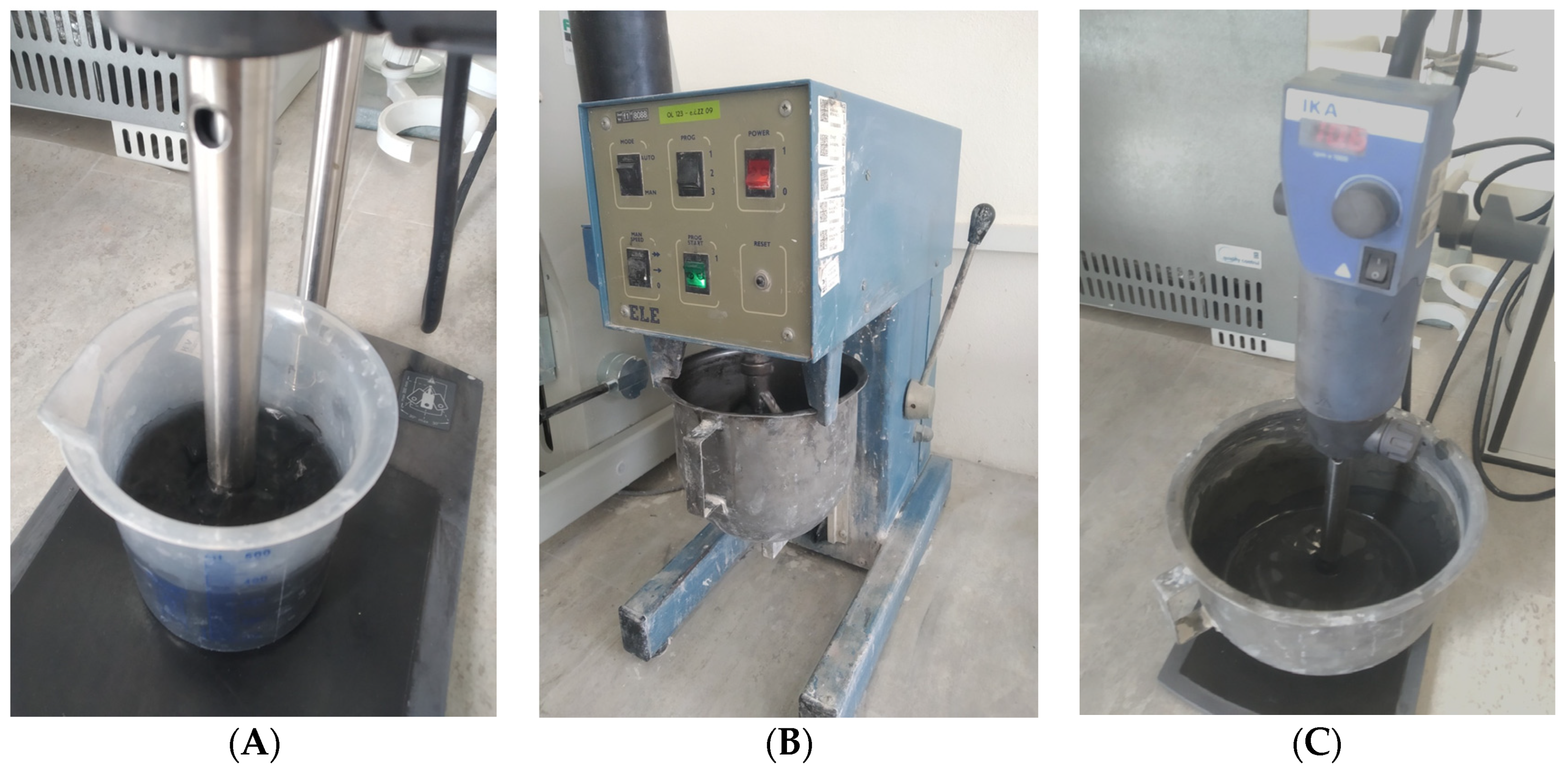
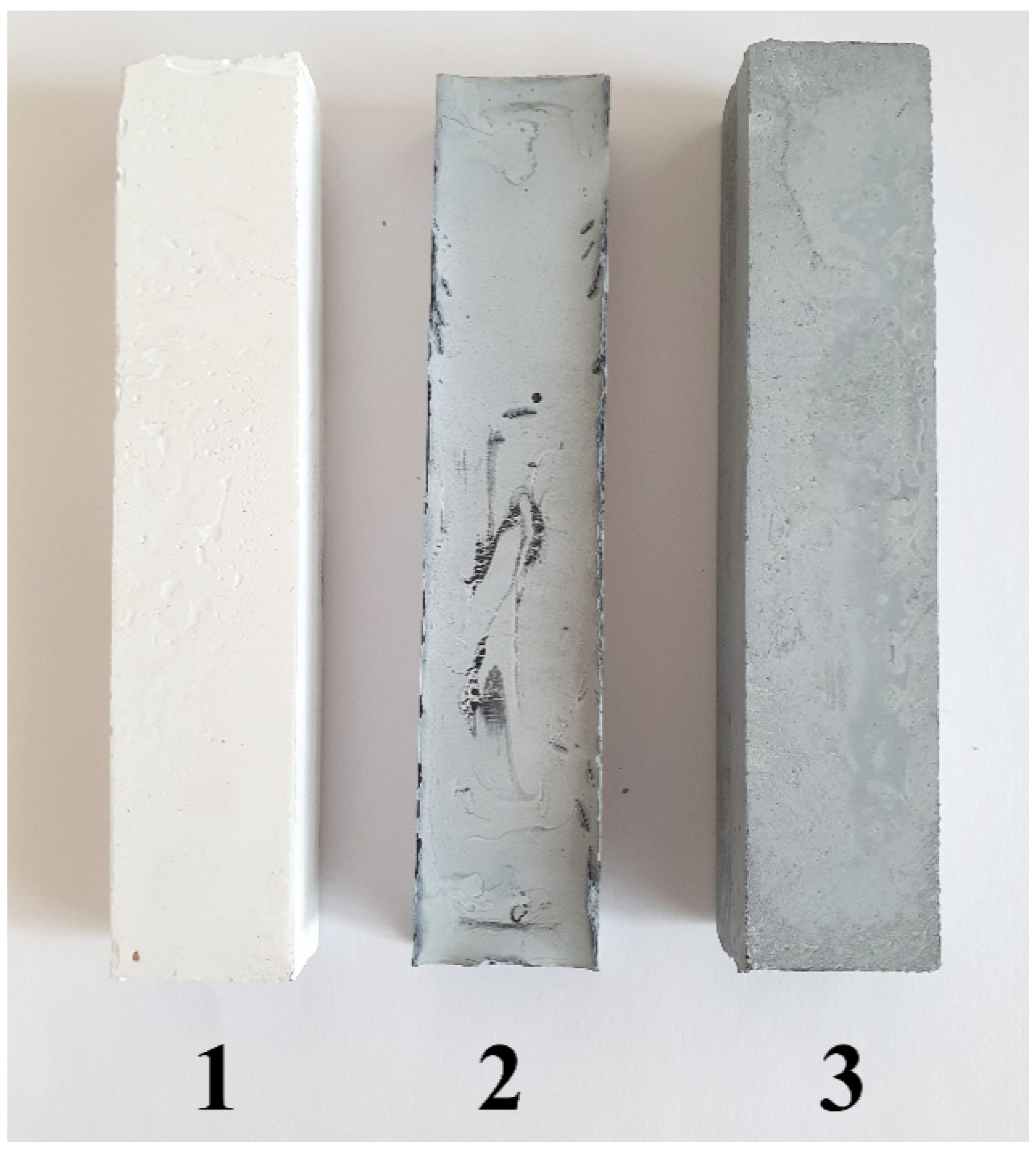

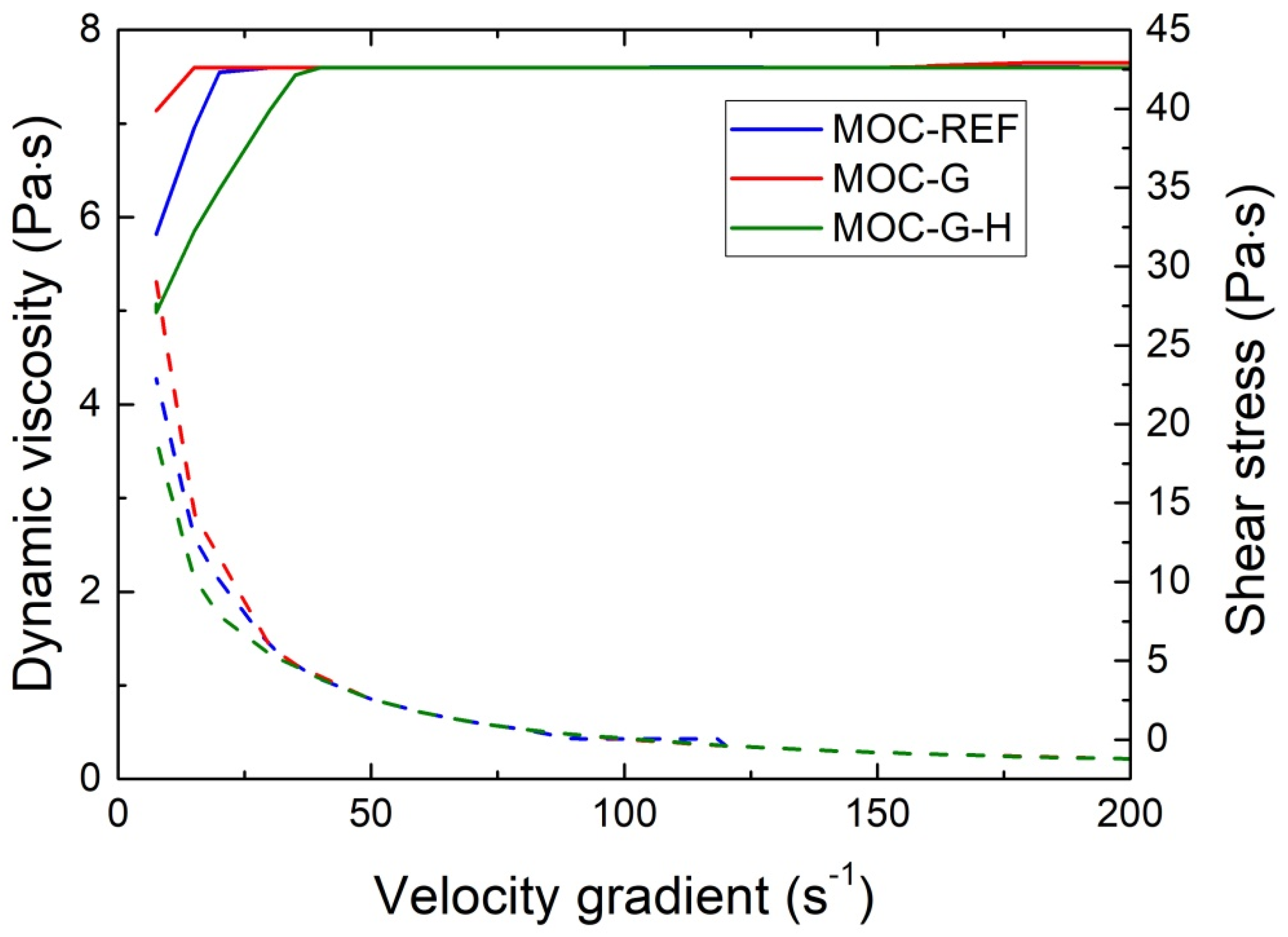
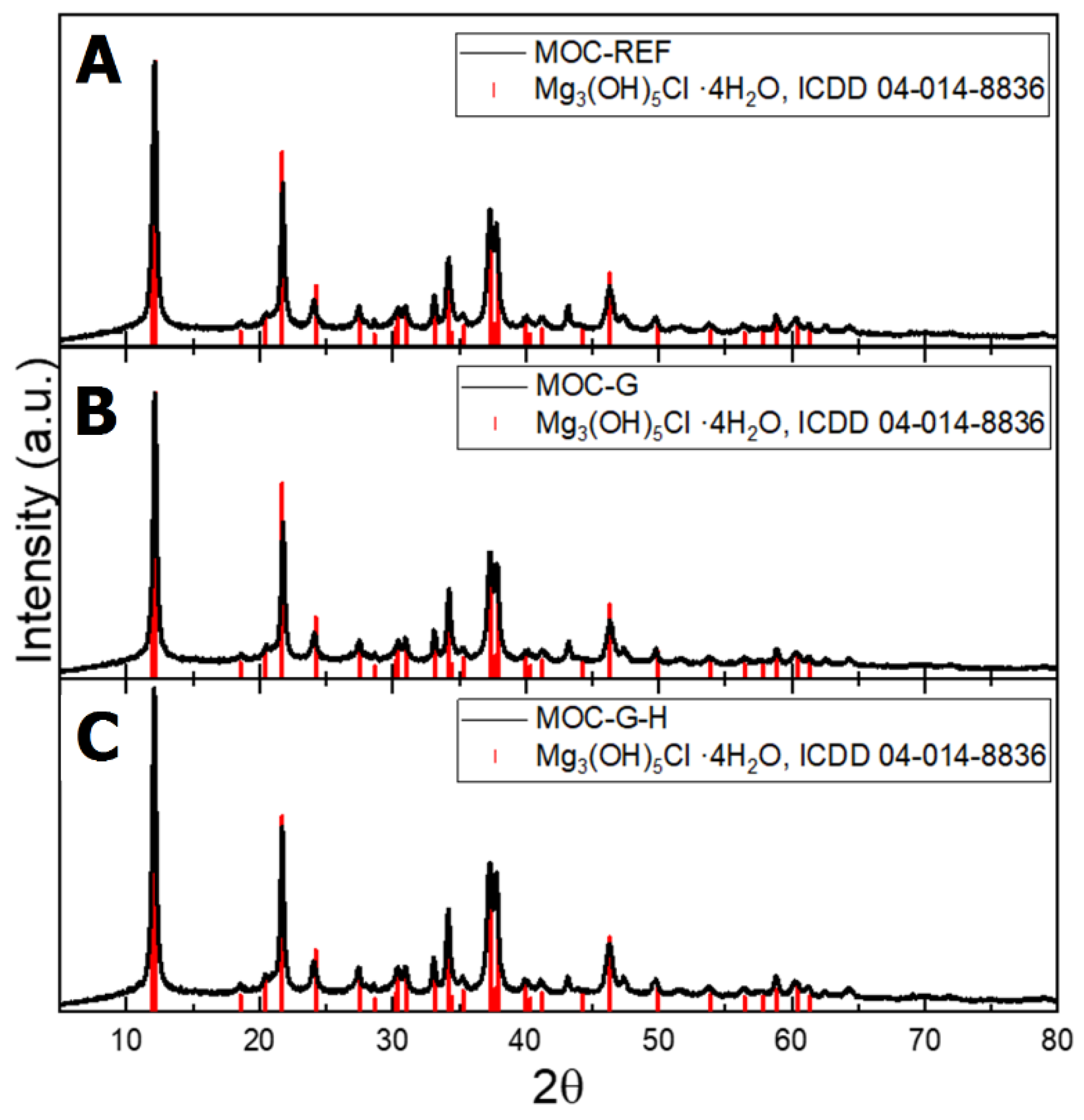
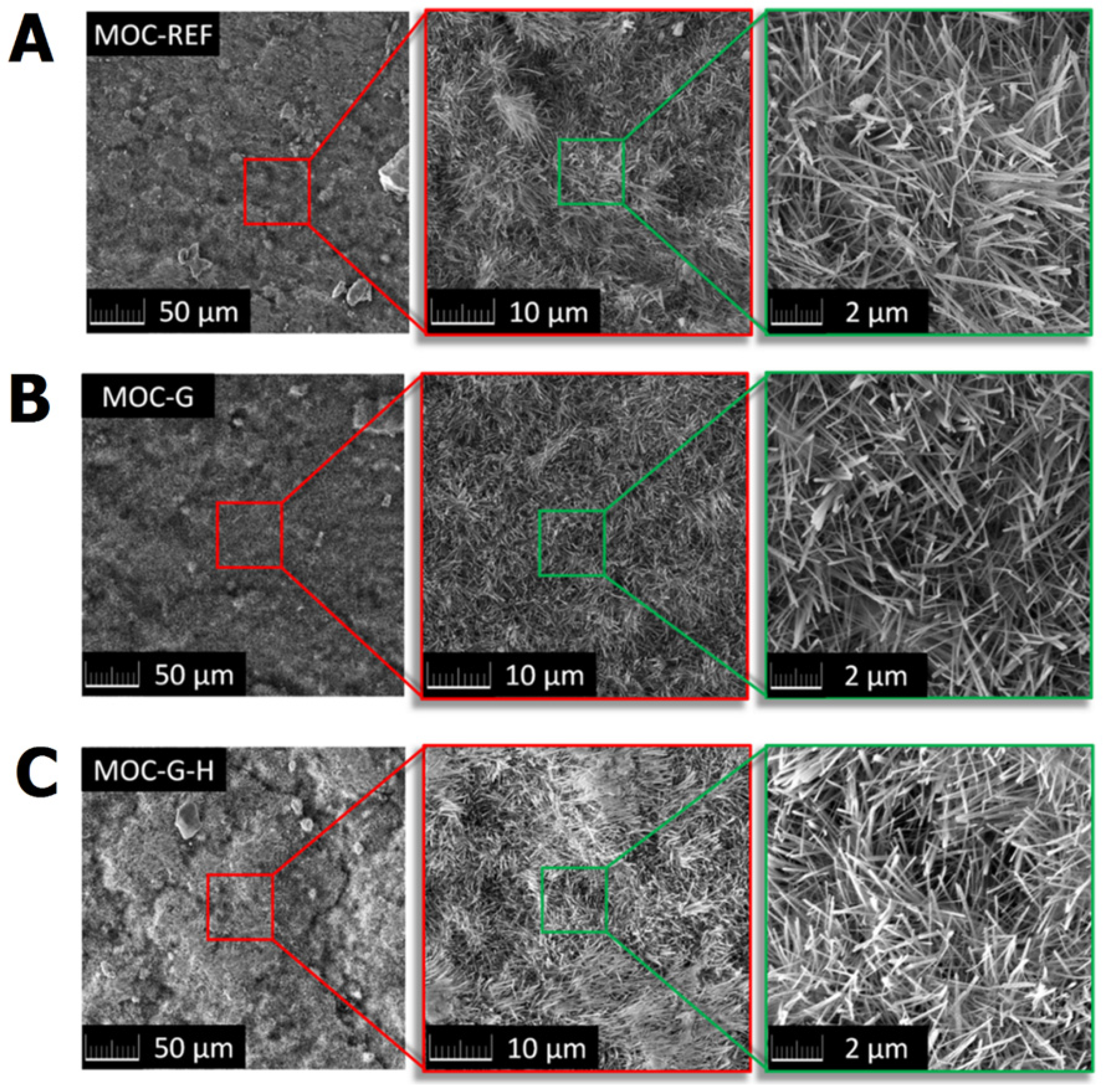
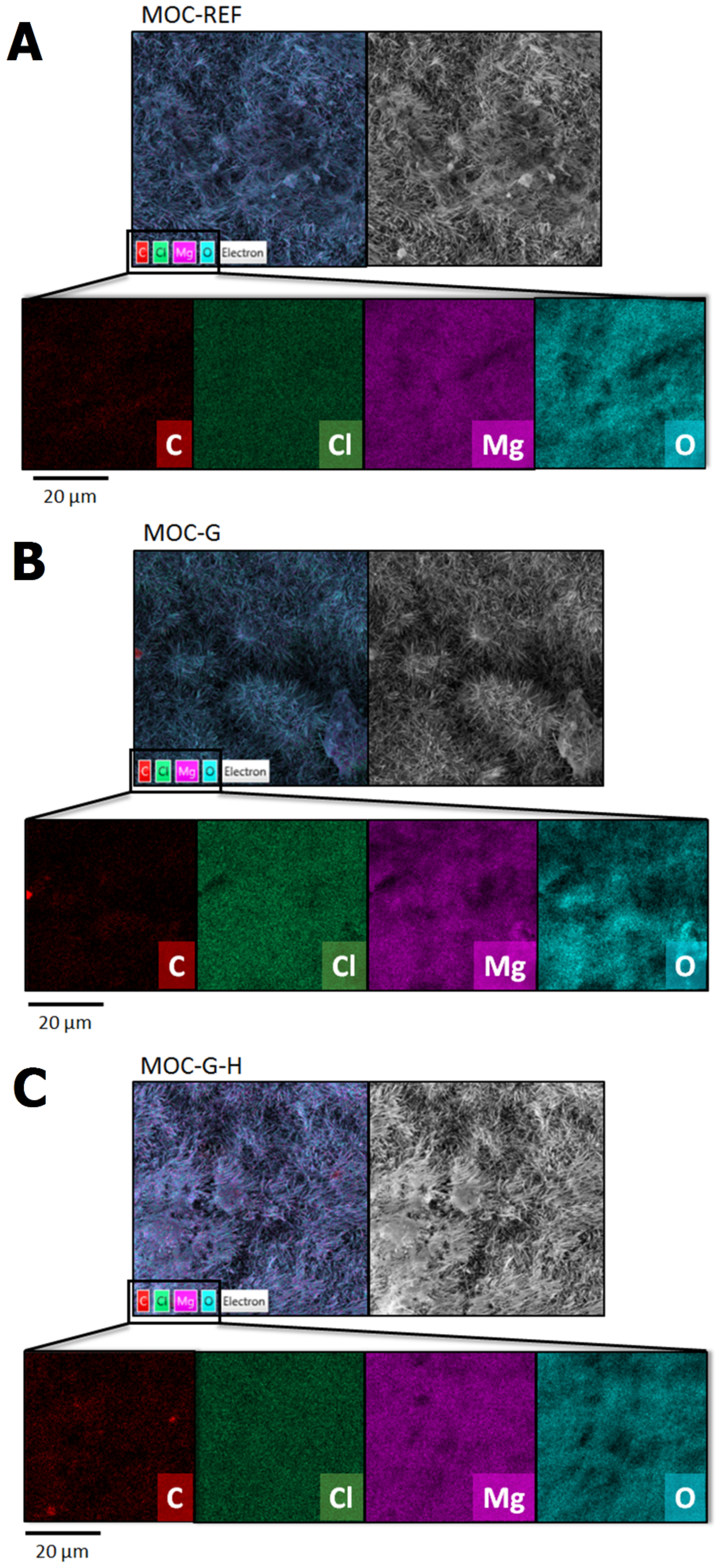
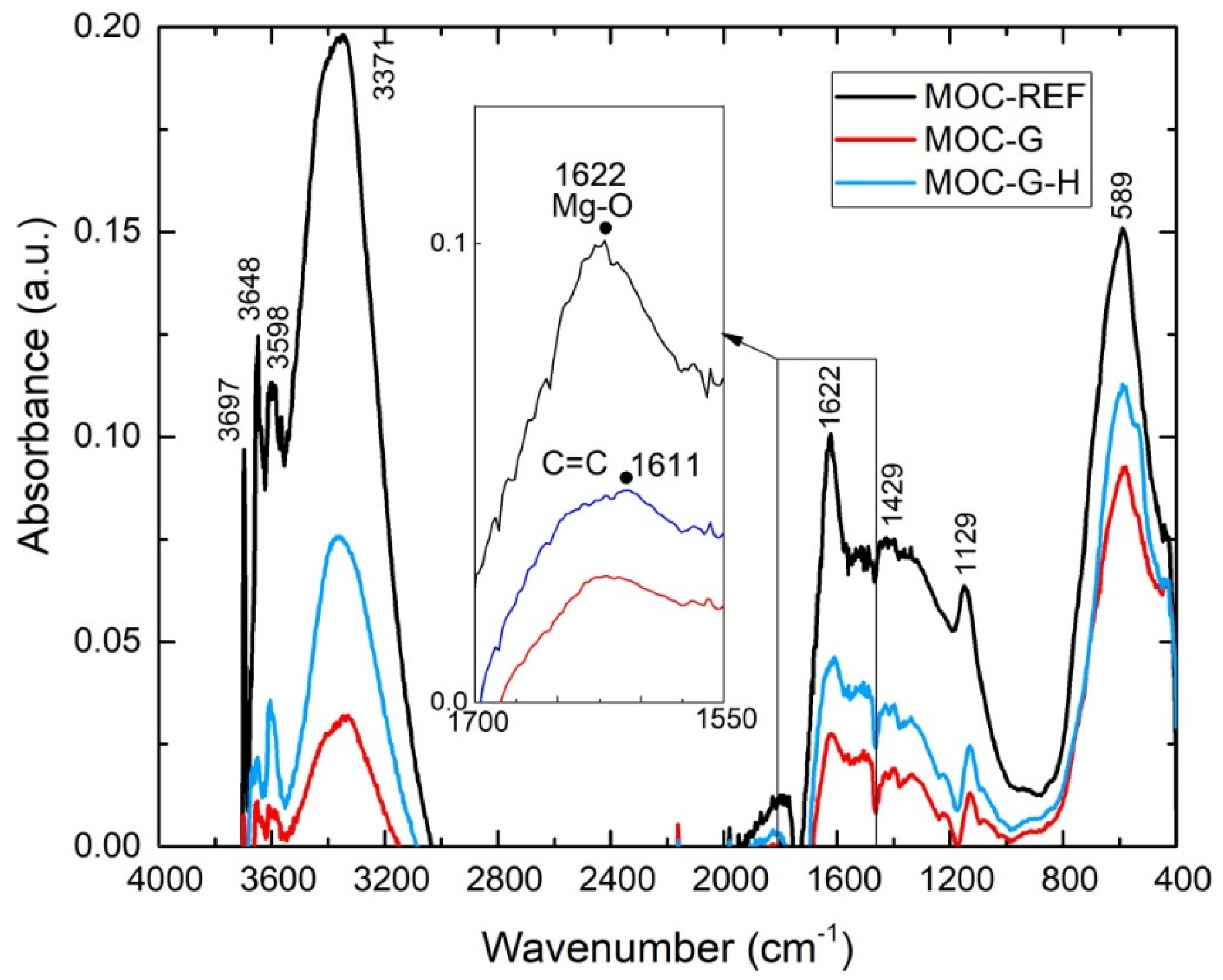
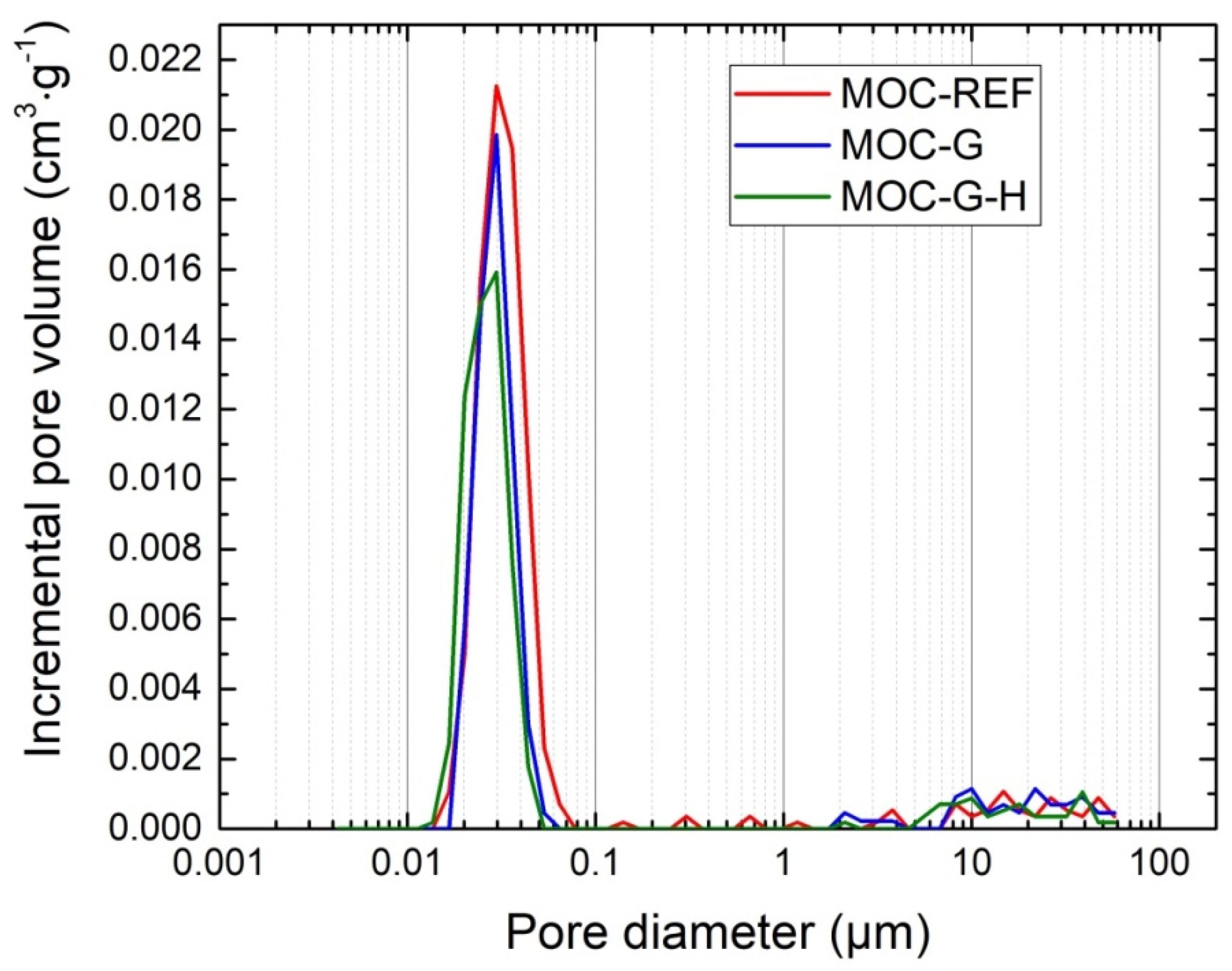
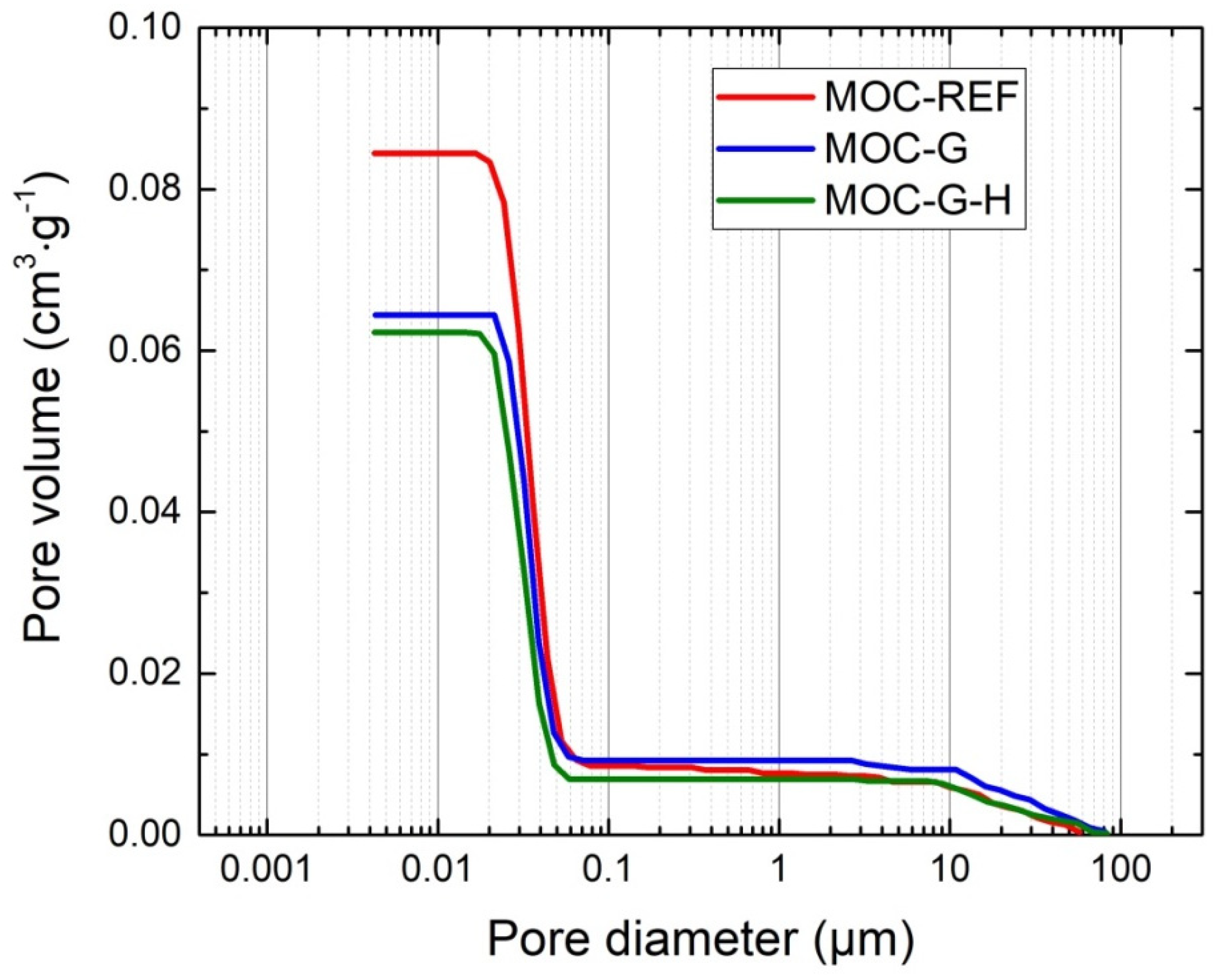

| Mixture ID | Mass (g) | |||
|---|---|---|---|---|
| Magnesia Powder | MgCl2·6H2O | H2O | Graphene | |
| MOC-REF | 900 | 908.4 | 562.1 | - |
| MOC-G | 900 | 908.4 | 562.1 | 9.042 |
| MOC-G-H | 900 | 908.4 | 562.1 | 9.042 |
| Wavenumber (cm−1) | Assignment |
|---|---|
| 3697, 3648, 3598 | stretching (ν) vibration of O-H in Mg(OH)2 |
| 3375–3346 | stretching (ν) vibration of H-O-H in H2O |
| 1646, 1608, 1157 | bending (δ) vibration of H-O-H in MgCl2·8H2O |
| 1622, 1429 | stretching (ν) vibration of Mg-O in MgCl2·8H2O |
| 1611 | stretching (ν) vibration of C=C |
| 844 | stretching (ν) vibration of Mg-O cubic structure |
| 668, 634 | stretching (ν) vibrations of Mg-O |
| 589 | deformation (δ) and stretching (ν) lattice vibrations of Mg-Cl/Mg-O |
| 535 | translation vibrations of Mg/Mg-O, Mg-OH |
| 440 | vibrational modes of the lattice showing the Mg-O/Mg2+, O/O-Mg-O/O-Mg2+-O bonds |
| Material | 7-Day Aged Samples | 14-Day Aged Samples | |||||
|---|---|---|---|---|---|---|---|
| ρb (kg·m−3) | ρs (kg·m−3) | Ψ (%) | ρb (kg·m−3) | ρs (kg·m−3) | Ψ (%) | ΨHg1 (%) | |
| MOC-REF | 1603 | 1867 | 14.2 | 1633 | 1887 | 13.5 | 13.4 |
| MOC-G | 1680 | 1854 | 11.2 | 1658 | 1857 | 10.7 | 10.4 |
| MOC-G-H | 1654 | 1848 | 10.5 | 1652 | 1818 | 9.1 | 9.8 |
| Parameter | MOC-REF | MOC-G | MOC-G-H |
|---|---|---|---|
| Total pore volume (cm3·g−1) | 0.0844 | 0.0644 | 0.0622 |
| Average pore diameter (µm) | 0.0295 | 0.0317 | 0.0320 |
Publisher’s Note: MDPI stays neutral with regard to jurisdictional claims in published maps and institutional affiliations. |
© 2021 by the authors. Licensee MDPI, Basel, Switzerland. This article is an open access article distributed under the terms and conditions of the Creative Commons Attribution (CC BY) license (http://creativecommons.org/licenses/by/4.0/).
Share and Cite
Záleská, M.; Pavlíková, M.; Pivák, A.; Marušiak, Š.; Jankovský, O.; Lauermannová, A.-M.; Lojka, M.; Antončík, F.; Pavlík, Z. MOC Doped with Graphene Nanoplatelets: The Influence of the Mixture Preparation Technology on Its Properties. Materials 2021, 14, 1450. https://doi.org/10.3390/ma14061450
Záleská M, Pavlíková M, Pivák A, Marušiak Š, Jankovský O, Lauermannová A-M, Lojka M, Antončík F, Pavlík Z. MOC Doped with Graphene Nanoplatelets: The Influence of the Mixture Preparation Technology on Its Properties. Materials. 2021; 14(6):1450. https://doi.org/10.3390/ma14061450
Chicago/Turabian StyleZáleská, Martina, Milena Pavlíková, Adam Pivák, Šimon Marušiak, Ondřej Jankovský, Anna-Marie Lauermannová, Michal Lojka, Filip Antončík, and Zbyšek Pavlík. 2021. "MOC Doped with Graphene Nanoplatelets: The Influence of the Mixture Preparation Technology on Its Properties" Materials 14, no. 6: 1450. https://doi.org/10.3390/ma14061450
APA StyleZáleská, M., Pavlíková, M., Pivák, A., Marušiak, Š., Jankovský, O., Lauermannová, A.-M., Lojka, M., Antončík, F., & Pavlík, Z. (2021). MOC Doped with Graphene Nanoplatelets: The Influence of the Mixture Preparation Technology on Its Properties. Materials, 14(6), 1450. https://doi.org/10.3390/ma14061450









